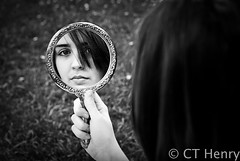1. Process your images. Don’t rely solely on the image that comes directly out of the camera. Photos that come right out of the camera usually look flat and unappealing. Ultimately, they fail to convey what the scene looked like when you took the picture. There are tons of software programs out there that will help you improve the sharpness, brightness, color, and overall tone of the photo: iPhoto, Photoshop Elements, Picasa, Aperture, Paint Shop Pro, Photoshop, Lightroom, and many more. While today’s digital photographers know that they can improve their images, many just aren’t willing to spend the time sitting in front of a computer. To take your photography to the next level, you must view the digital darkroom as part of the overall process to create powerful photographic images. Most people like the idea of becoming a photographer, but some don’t like the process. It’s hard work.
Once I show my students the difference between a shot right out of the camera and a processed image, they start to believe that the amount of time spent improving the photograph is totally worth it. If you love photographs, you’ll want to create the best possible image.
2. Print some of your best images. There’s nothing better to the ego than a nice big print of something that you shot. Treat yourself to an 8×10 or larger. If you don’t have your own printer, I recommend using Mpix.com. It’s quick and easy. Mpix’s slogan is “Shoot Today. Upload Tonight. We Ship Tomorrow.” Their prints are stunning! If you have a Mac, you can even use iPhoto and order custom prints. However, the quality just isn’t the same as Mpix. Whatever print store or online store you use, just get some prints. Having them in your hand will be worth it!
You can also learn a lot from a printed image. Sometimes the LCD screen on the back of the camera can fool you. After a few weeks of shooting, I ask my students to send me their two best images, and then I print them out. We have a critique session, and the students find areas that they can improve. Mostly they find that the object that they meant to be in focus, isn’t in focus at all. Others see how they could’ve composed the scene more appropriately. To become a better photographer, learn from your printed photos.
3. Share your images. DON’T live in a creative vacuum; join a photo-sharing community. It’s essential to see what other photographers are doing creatively and receive feedback on your images. You can even join groups who own the same camera that you do. Two of the most popular ways to share your photos is to post them to Flickr or Facebook.
Flickr is the ultimate photo-sharing site for beginners and intermediates, where you can get immediate feedback from other photographers. After you upload some pictures, join Flickr groups that you might interest you. If you want instant recognition, become a member of award groups like Flicker’s Got Talent. Here you post your image, give five other members an award, and then sit back and wait for the members to shower you with awards. You can even post your best images to a group called National Geographic: Are You Good Enough? If you want more critical feedback, join groups like Life Thru A Lenz or Truly Constructive Criticism. If you like landscapes, join a landscape group. If you like portraits, join a portrait group. From time to time, it’s also fun to meet with a group of photographers in your area. You can even sign up with a Flickr Meetup group. When I lived in London, I was a member of the London Flickr Meetups group that went on a night photography shoot together. The possibilities and the fun are endless.
Facebook is another great place to share your photos. By simply posting your photo, friends can comment or click the “Like” button. There’s nothing better than having your friends tell you how much they love your images.
Whatever you do, don’t let your images simply exist on your camera’s memory card or sit idle on your hard drive. You have to let your photos go out into the world.
Next Post: 10 Tips for your next Photo Trip











